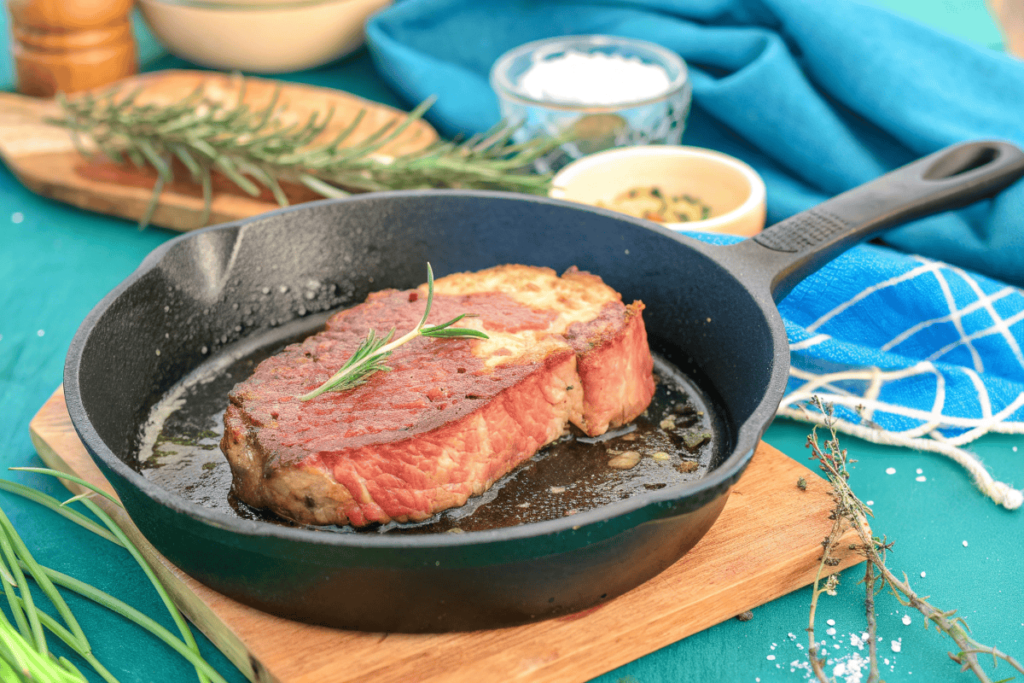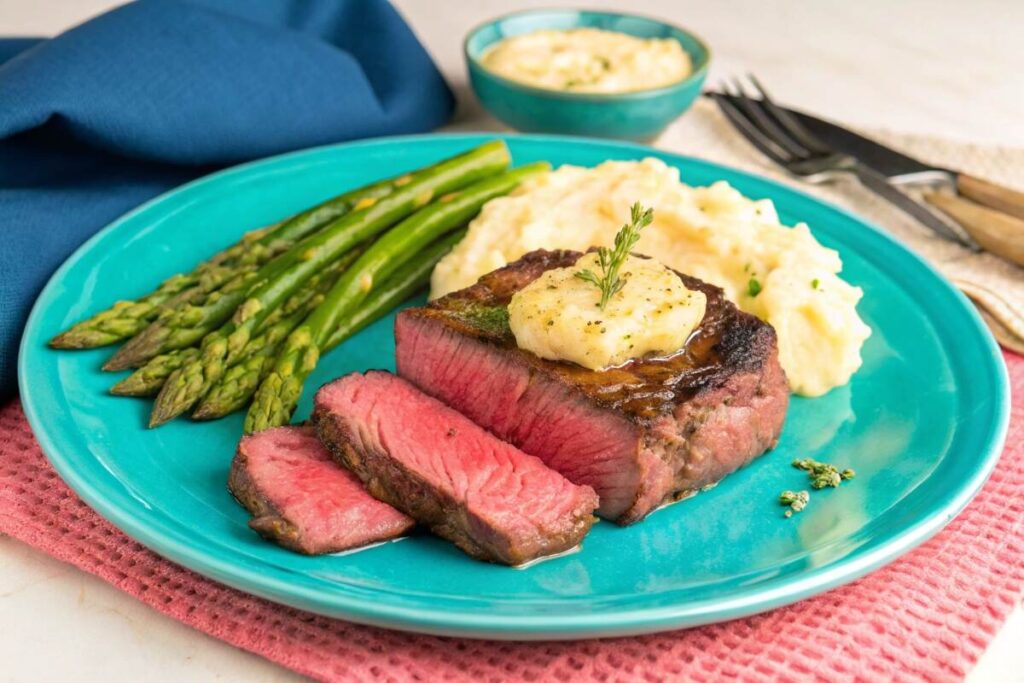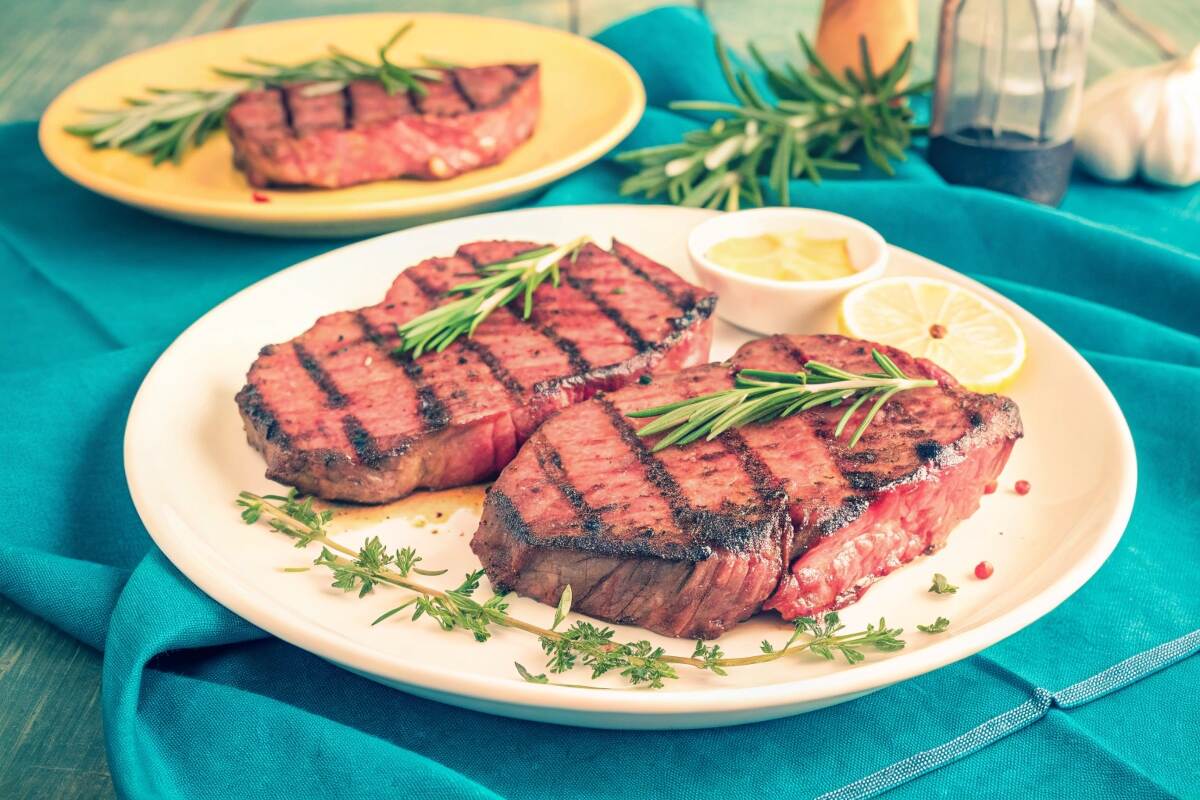The Delmonico steak, a culinary legend, evokes images of elegant dining and rich, savory flavors. Steeped in history, this classic cut has graced tables for generations. With this Delmonico steak recipe, you can bring that restaurant-quality experience right into your own kitchen. Prepare to be amazed by how easily you can create a truly memorable meal. This guide will walk you through each step, from selecting the perfect cut to achieving a perfect sear.
Why this Delmonico steak recipe is special
This Delmonico steak recipe emphasizes simplicity and maximizing the natural flavors of the beef. We’ll focus on achieving a flavorful crust through searing and share tips for cooking the steak to your preferred doneness. With easy-to-follow instructions, you’ll create a delicious, mouthwatering Delmonico steak that rivals any steakhouse.
What is a Delmonico Steak?
The Delmonico steak carries a legacy that dates back to the mid-19th century, originating at Delmonico’s Restaurant in New York City. Considered by many to be America’s first fine-dining restaurant, Delmonico’s established a reputation for serving top-quality cuts of beef. While the exact cut used for the original Delmonico steak remains a subject of debate among culinary historians, it’s widely accepted that it was a premium, richly marbled cut. Today, the term “Delmonico” often refers to a boneless ribeye, known for its tenderness and flavor. However, other cuts like the chuck-eye and short loin can also be prepared as a Delmonico steak.
Over time, various cuts, including the chuck-eye and short loin, have also been served as “Delmonico” steaks. This has led to some confusion about the precise definition. Regardless of the specific cut, a Delmonico steak is typically thick-cut, well-marbled, and cooked to enhance its inherent rich flavor.
Delmonico Steak vs. Ribeye
The terms “Delmonico steak” and “ribeye” are often used interchangeably, particularly in modern steakhouses and butcher shops. The ribeye, with its abundant marbling and rich flavor, is the most common cut associated with the Delmonico name. However, some argue that a true Delmonico involves a specific preparation or aging process beyond simply using a ribeye cut. The key takeaway is that while a ribeye is often a Delmonico, not every Delmonico is necessarily a ribeye. The historical ambiguity allows for flexibility in interpretation.
Ingredients and Equipment

For this Delmonico steak recipe, you’ll need a few key ingredients:
- Delmonico Steak: 1-2 Delmonico steaks (ribeye), about 1.5-2 inches thick – choose well-marbled cuts for optimal flavor.
- Kosher Salt: 1-2 teaspoons
- Freshly Ground Black Pepper: ½-1 teaspoon
- High-Heat Cooking Oil: 2 tablespoons (e.g., canola, grapeseed, or avocado oil)
- Butter: 2 tablespoons
- Garlic Cloves: 2-3, smashed (optional)
- Fresh Thyme Sprigs: 2-3 (optional)
Equipment:
- Cast-iron skillet (highly recommended) or heavy-bottomed skillet
- Meat thermometer
- Tongs
- Small bowl
- Baking sheet (if oven-finishing)
Choosing the Right Delmonico Steak
Look for steaks with good marbling (thin white lines of fat throughout the meat) for maximum flavor and tenderness. Aim for a thickness of 1.5-2 inches for optimal cooking. Whenever possible, source your steaks from a reputable butcher or grocery store for quality assurance.
Delmonico Steak Recipe: A Step-by-Step Guide
- Prepare the Steak: Pat the Delmonico steaks dry with paper towels. This crucial step helps achieve a good sear. Season generously with kosher salt and freshly ground black pepper on both sides.
- Sear the Steak: Heat the cooking oil in a cast-iron skillet over medium-high heat until it shimmers. Carefully place the steaks in the hot skillet and sear for 3-4 minutes per side, undisturbed, to develop a rich, brown crust.
- Optional Oven-Finishing: For thicker steaks or desired higher internal temperatures, transfer the skillet to a preheated oven at 400°F (200°C). Continue cooking until the desired internal temperature is reached (see “Checking for Doneness”).
- Add Butter and Aromatics (Optional): During the last few minutes of cooking, add butter, smashed garlic cloves, and thyme sprigs to the skillet. Tilt the skillet and baste the steaks with the melted butter for added flavor.
- Rest and Serve: Remove the steaks from the skillet and let them rest on a cutting board for 5-10 minutes before slicing and serving. This allows the juices to redistribute, resulting in a more tender and flavorful steak.
Searing the Delmonico Steak

Creating a perfect sear is the key to a flavorful Delmonico steak. Ensure your skillet is hot enough before adding the steaks. The oil should shimmer, and the steaks should sizzle immediately upon contact. Avoid overcrowding the pan, which can lower the temperature and prevent proper searing. Use tongs to flip the steaks, avoiding piercing the meat with a fork, which can release juices.
Checking for Doneness
Use a meat thermometer for accurate doneness. Insert it into the thickest part of the steak, avoiding bone. Here’s a guide:
- Rare: 125-130°F (52-54°C)
- Medium-Rare: 130-140°F (54-60°C)
- Medium: 140-150°F (60-66°C)
- Medium-Well: 150-160°F (66-71°C)
- Well-Done: 160°F+ (71°C+)
Resting the Steak: Why It Matters
Resting the steak allows the muscle fibers to relax and reabsorb the juices that were driven to the center during cooking. This results in a more tender and evenly juicy Delmonico steak. Don’t skip this step!
Enhancing Your Delmonico Steak
A perfectly cooked Delmonico steak is delicious on its own, but a few simple additions can elevate it to an extraordinary dining experience. Consider adding a flavorful compound butter, a rich pan sauce, or carefully selected side dishes to complement the steak’s richness.
Compound Butter Recipes
Compound butters are a simple yet elegant way to add flavor and richness to your Delmonico steak. Here are a few ideas:
- Garlic Herb Butter: Combine softened butter with minced garlic, chopped fresh parsley, thyme, and a pinch of salt.
- Blue Cheese Butter: Mix softened butter with crumbled blue cheese, a splash of Worcestershire sauce, and a pinch of black pepper.
- Red Wine Butter: Reduce red wine with shallots and thyme until syrupy, then whisk into softened butter.
Perfect Side Dishes for Delmonico Steak
The right side dishes can enhance the flavors of your Delmonico steak and create a balanced, satisfying meal. Consider these classics:
- Roasted Vegetables: Asparagus, Brussels sprouts, or carrots roasted with herbs and a touch of balsamic vinegar provide a fresh counterpoint to the richness of the steak.
- Mashed Potatoes: Creamy mashed potatoes, whether classic or with roasted garlic or herbs, are a comforting and flavorful accompaniment.
- Creamed Spinach: Rich and decadent creamed spinach complements the steak’s savory flavors beautifully.
- Simple Salad: A light and refreshing salad with a vinaigrette dressing can balance the richness of the steak.
Frequently Asked Questions
What is the best way to cook Delmonico steak?
Pan-searing is a popular and effective method for cooking Delmonico steak, creating a beautiful crust and maximizing flavor. Grilling is another excellent option, imparting a smoky char. Broiling works well for thinner cuts. The best method depends on your equipment and preferences.
What makes a steak a Delmonico?
Historically, the exact cut for a Delmonico steak has been debated. Today, it commonly refers to a well-marbled, thick-cut ribeye. However, other cuts like the chuck-eye or short loin can also be prepared as Delmonico steaks. Key characteristics include rich flavor and tender texture.
Which cooking method would be most appropriate for a Delmonico steak?
For thicker Delmonico steaks, pan-searing followed by oven-finishing ensures even cooking. Thinner steaks can be pan-seared or grilled. If you prefer a smoky flavor, grilling is ideal. Broiling is suitable for quick cooking of thinner cuts.
Does Delmonico steak need to be marinated?
Marinating a Delmonico steak isn’t essential, as its rich flavor stands on its own. However, a marinade can add tenderness and enhance the flavor profile. Simple marinades with olive oil, herbs, garlic, and a touch of acid (like lemon juice or vinegar) work well.
Serving and Storing
Once your Delmonico steak has rested, slice it against the grain into ½-inch thick slices. This helps ensure tenderness. Serve the steak on warm plates, optionally garnished with a pat of compound butter or a drizzle of pan sauce. Pair with your chosen side dishes for a complete and satisfying meal.
Store leftover Delmonico steak in an airtight container in the refrigerator for up to 3 days. For longer storage, wrap the steak tightly in freezer paper or plastic wrap and freeze for up to 2 months.
Reheating Delmonico Steak
The best way to reheat Delmonico steak is gently, to avoid overcooking. Place the steak on a wire rack set over a baking sheet. Preheat your oven to 250°F (120°C) and reheat the steak for about 15-20 minutes, or until warmed through. Alternatively, you can reheat it in a skillet over low heat with a little bit of butter or oil, flipping occasionally, until heated through.
Conclusion
With this Delmonico steak recipe, you can create a restaurant-worthy meal in the comfort of your own home. From selecting the perfect cut to mastering the sear, you’ll be equipped to impress yourself and your guests. The rich flavor and tender texture of a perfectly cooked Delmonico steak is a culinary experience not to be missed. So, gather your ingredients, fire up your skillet, and prepare for a truly satisfying meal. Share your Delmonico steak triumphs in the comments below!
Want a complete Grilled Delmonico Steaks? This Wake-Up Casserole is a great option!

